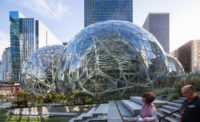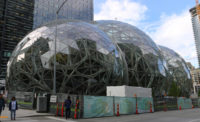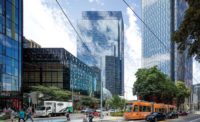NBBJ’s design for Amazon’s new and massive Seattle headquarters was revealed in greater detail this month. Renderings of the project’s street level presence, unveiled in a meeting with the city’s Design Review Board (DRB) on August 14, show asymmetrical towers, mid-rise buildings of varying size, and mid-block open spaces, representing a scale of development unprecedented in Seattle’s history.
The 3.3-million-square-foot project spanning three city blocks is on track to start construction next year. It will consolidate Amazon’s currently dispersed operations in leased buildings into an owner-developed campus between Seattle’s commercial core and the neighborhood of South Lake Union. The project’s location, known as the Denny Triangle, is currently an under-developed, in-between space, comprised largely of parking lots and car dealerships.
“From the urban development perspective, a large company moving downtown again is great for the city,” says Gundula Proksch, design professional representative on the DRB and assistant professor in the Department of Architecture, University of Washington, “as opposed to another huge development in the suburbs, which takes energy away from Seattle. The community, I think, sees that.” At this stage, municipal review is focused on the quality of the project’s proposed open spaces. The DRB has expressed reservations about where the balance in these publicly accessible but privately owned spaces will fall. Some of the current detailing expresses private ownership more strongly than public invitation, notes Proksch. “I’m a little skeptical that the design moves will have the character of a truly public space.”
The proposed design eliminates through-block alleys on each affected block, and requires variances to Seattle’s development standards with regard to building form and setbacks. Amazon is expected to offer significant community amenities in exchange for approval of these variances. To date these consist of un-programmed public open space and a dog park. A children’s play area would be welcome in the neighborhood, whether on-site or on one of the awkward triangles created by a diagonal through street, but so far Amazon has not taken up this suggestion.
Community interest in the project has been strong. Some 300 people attended Amazon’s initial design review in March, compared with a DRB hearing’s more typical 20. By the August review, protesters against Amazon’s business practices had fallen away, as had others reassured by the direction of the project, leaving some 50 attendees with a continuing interest in the design and its impact on their city. While some commentators have expressed disappointment that the architec-ture is not more spectacular, the proposed development has been generally well received.
The architects are scheduled to show the project to the DRB for final approval in September, in anticipation of a Master Use Permit by the end of the year.










